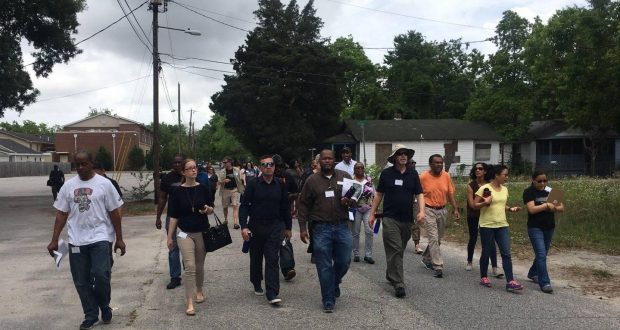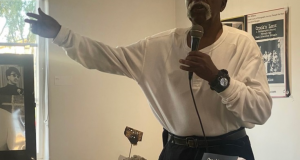Green Living Plan: Clearly a major clean energy transition is taking place, with jobs being created. But do the most marginalized and climate-hit communities even know how to access all of this?
By Jessika Pollard | a University of Redlands partnership
According to Pew Research during the 2020 elections, 70 percent of registered America voters identified climate change as an important factor influencing their choices in the presidential election. Since then, in a commitment echoing his campaign promises, President Joe Biden has set forth an extremely ambitious vision: A carbon pollution-free power sector by 2035 and net zero emissions by 2050. This transformative agenda includes climate forward legislation including the Inflation Reduction Act (IRA), the Bipartisan Infrastructure Law (BIL) and the Infrastructure Investment and Jobs Act (IIJA) – or combined spending of $3.5 trillion. It represents what Biden and other observers have called the “largest ever investment in clean energy research and innovation.”
Fast forward a few years later and the IRA specifically, is calculated to decrease the national deficit by $300 billion over the next 10 years through funding initiatives that advance environmental justice, cut emissions, manufacture clean energy products, and more. Also within that time frame, this initiative is expected to create more than 9 million well-paying clean energy jobs – averaging 912,000 annually. Roughly $400 billion will be injected into various sectors and communities across the U.S., including millions of dollars in incentives for private investment, in the form of tax incentives, grants, loans, and more.
As President Biden and the U.S. Congress attempt to fulfill these promises, tangible results are already surfacing. For example, since its passage, the IRA has created over 100,000 clean energy jobs in (notably ‘red’) states such as Georgia, Kansas, Tennessee, and Arizona. Nationally, reports from companies across the country indicate nearly $90 billion in new investments have been established. Additionally, President Biden has recently announced the new Hydrogen Hub in Philadelphia that will create 20,000 new jobs.
Yet, the impact of these initiatives extends beyond the economic figures of for already affluent areas. What does this mean for families and communities in dis-invested areas? President Biden’s climate plan not only set ambitious goals for carbon emissions and clean energy, but also to fortify the national climate resiliency. Still, the realization of this vision hinges on aggressive investments in marginalized and vulnerable communities, often overlooked and underserved. In many low-income communities of color, the absence of critical infrastructure and healthy environments poses significant challenges to healthy, stable, and thriving living spaces.
Recognizing the interconnectedness of “Neighborhoods and Environment” as one of the six domains of Social Determinants of Health (SDOH), classified by the World Health Organization (WHO) underscores the urgency of reinvestment. These SDOHs are the underlying conditions that are contributing factors of health inequities. The lack of adequate and affordable housing, poor air quality, and lack of infrastructure for safe drinking water and accessible electricity are all results of a disinvested community. American dependency on oil and gas has only exacerbated the challenges these communities regularly face. The monies appropriated from the Biden climate plan are essential to see transformative investments in these underserved, low-income communities of color, steering the nation toward a more equitable and sustainable future. But: Do those communities even know those funds are available and, supposedly, accessible?
How Are Funds Being Planned?
A number of states, such as California, Vermont, and New York, are already working toward environmental justice polices – such as oil and gas drilling regulations or cap and trade – that mitigate air pollution in economically disadvantaged neighborhoods and communities of color. These efforts aim to alleviate the poor air pollution in economically disadvantaged communities. The success in those investments from climate policies rely heavily on the collaboration between local, state, and federal policymakers and mission driven organizations actively engaged in the field.
The IRA, coupled with the BIL infrastructure law, represents significant investment in these targeted areas, aiming to enhance the nation’s infrastructure and transportation networks. Initiatives such as modernized home electrification, rebates, and grants/loans for zero emission technology, empower lower income households to invest in public safety and escape unhealthy living conditions.
Consumers also stand to benefit from incentives including tax rebates on energy-efficient appliances, home improvement, and electric vehicles. To ensure effective allocation of funds in line with the U.S. climate goals, the National Caucus of Environmental Legislators propose three strategies: green banks, creating agency guidance and requirements, and creating funding streams for state funding matches.
An estimated $30 billion from the IRA is to be allocated to state and local governments and nonprofit entities, or Green Banks, intended to accelerate the transition to clean energy and fight climate change. Moreover, the opportunity to have IRA and IIJA funds matched by state governments creates greater opportunity for the much needed investments for increased infrastructure in communities requiring immediate attention.
Analyzing potential benefits, Rewiring America provides insights into the positive outcomes of Bringing Infrastructure Home. Properly distributing and implementing funds within communities will help lower energy costs and expenses related to upgrades, not to mention. The findings suggest major benefits to indoor and outdoor air quality for low-income households just by updating home electrification. Furthermore, a modernized electrification system will save low-income households close to $500 annually, decreasing their percentage of rent burden; however, these numbers are only realized if community revitalization is prioritized.
How Will We Know It’s Working?
As previously mentioned, since its passage, the IRA has already proved valuable in achieving specific climate goals set by President Biden; however, to what extent has that included disinvested, marginalized communities? And do they know what’s happening?
Here’s what was promised …
- Incentivize clean energy
- Increase nationwide energy efficiency
- Increase access and affordability of electric vehicles
- Create more jobs
- Advance clean air and transportation
- Lower healthcare costs
At this rate, domestic carbon emissions are expected to experience a 40 percent reduction by 2030. Noteworthy is the surge in planned manufacturing sites that will promote and support the development and use of renewable energy sources such as battery and electric vehicle manufacturing sites and wind and solar manufacturing sites. Furthermore, we have also seen an increase in planned green banks across the country to make the transition to clean energy more widespread and as previously mentioned, numerous jobs have been created and wages raised, contributing to the economic mobility of many families across the country.
What we’ll need to know, however, is if there is an increase in jobs and economic growth in the most disadvantaged communities. Do low-income, traditionally low-resources Black and Brown communities even aware that they’re able to participate in this massive transition taking place?
This climate legislation was diligently crafted in the application process in that it allows cities to seek funding independently if the state government refuses. To avoid a blocking of these initiatives where Republican-run states refused funds, as seen with the Affordable Care Act, the IRA extends the offer to the three largest cities in the state. For instance, Florida, South Dakota, Iowa, and Kentucky have all refused funds from the IRA, but cities such as Iowa City, Rapid City, and Louisville are attempting to take full advantage of these funds.
While it is still a bit too early to determine the effectiveness of the place-based incentives a discernible trend is emerging. We can track that many of the deployed IRA investments have been distributed to low-income communities due to place-based bonuses offered in the IRA. These bonuses are targeted for investments in low income high unemployment areas to ensure the most promising regions for growth are invested. As more funds are disbursed and data accrues, the optimistic anticipation of success continues to grow. Still, we need to keep asking and assessing if those populations know about these funds and that they’re circulating on their behalf. It’s not clear that they do. That also poses a problem for policymakers as they’ll need a combination of community input and partnership.
 Westside Story Newspaper – Online The News of The Empire – Sharing the Quest for Excellence
Westside Story Newspaper – Online The News of The Empire – Sharing the Quest for Excellence





